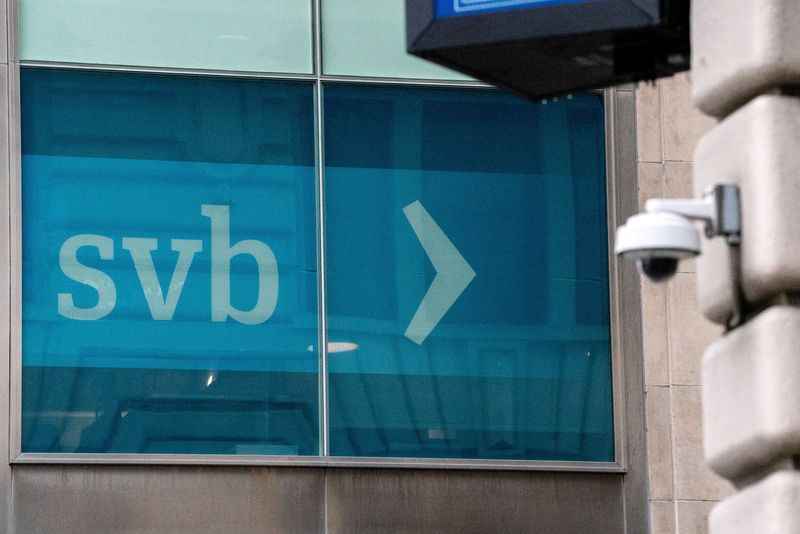
© Reuters. A view of the Park Avenue location of Silicon Valley Bank (SVB), in New York City, U.S., March 13, 2023. REUTERS/David ‘Dee’ Delgado
By Safiyah Riddle
(Reuters) – Friday kicks off a week or more of earnings reports from U.S. banks covering the April-through-June period, the first full quarter of operations for the nation’s lenders following the collapse of Silicon Valley Bank in mid-March.
A top 20 bank at the time of its failure, many analysts, economists and policymakers fretted SVB’s demise – and the failure of two other large regional banks in its wake – would hasten a credit crunch that would further aggravate financial conditions that had already tightened dramatically over more than a year of Federal Reserve interest rate increases. Some predicted it would tip the economy into recession.
That has not happened – yet. Bank credit growth began slowing in the second half of last year and has slowed further since the SVB failure, although that deceleration has not been uniform. Consumer lending has remained relatively robust, for instance, while some categories of business credit have shown more substantial slowdowns in growth.
The lenders due to report their second-quarter results in the days ahead will have much more to say about this still-evolving picture. Meanwhile, here’s a look at the current state of the bank credit scene, according to data published each week by the Fed.
OVERALL CREDIT
Annual growth in credit from U.S. banks has contracted to decade lows and looks likely to turn negative before long. Overall credit provided by U.S. banks is divided by the Fed into two broad buckets, securities and loans.
Securities, which includes bonds and other Wall Street-type assets held on banks’ balance sheets, have fallen by more than 10% on a year-over-year basis, the fastest rate ever. A substantial part of that is due to the value of those securities taking a big hit from the Fed’s rate hikes because as rates go up, bond prices fall.
Growth in loans, which represent 70% of all bank credit, have remained more stable by comparison, but they are showing some signs of weakness too: Growth rates are near the historical averages but are also on the decline across all categories.
LOAN TYPES
The Fed splits loans into four categories: Commercial & industrial, or C&I; real estate; consumer; and all other.
C&I loans were up just 3.4% near the end of June, down from double-digit increases earlier in the year and the lowest level in a year.
By contrast, growth in consumer borrowing has cooled at a slower pace after peaking in June 2022 and hovered around pre-pandemic levels for the past couple of months.
At the same time, the real estate market had a more prolonged period of growth amidst the pandemic-era housing boom, and continues to grow at the fastest rate of all categories at 8% annually.
CONSUMER CREDIT
The Fed splits this category into three tranches: credit cards, auto loans and all other consumer loans.
Bank credit card lending is the largest of the three at nearly $1 trillion, a record. Its growth rate, though, peaked in October 2022 after two years of strong increases and has moderated since.
The main drag on consumer lending is auto loans. Annual growth peaked there in early 2022 and turned negative in April and as of the end of June had reached negative 1% – the lowest rate since the Fed started tracking it separately in 2015. At the same time, used car prices plummeted at the fastest pace since the pandemic, at a rate of 4.2% annually, and the cost of new cars flatlined.
REAL ESTATE
This is divided between residential real estate and commercial real estate, or CRE, and investors will be looking closely at U.S. banks’ CRE exposures in particular as those earnings reports begin rolling out on Friday.
Both CRE and residential real estate loans are still rising year over year, but at a much slower pace. The switch to work-from-home arrangements for many office workers has sunk demand for office real estate, and demand for residential housing has weakened in the face of sky-high mortgage rates brought on by the Fed’s rate hikes.
DEPOSITS
Bank executives’ comments about deposits will be a big focus over the reporting season.
The collapse of SVB and two other large U.S. lenders caused a hasty withdrawal of deposits from small banks in particular in March.
Deposit levels have fallen for big banks for more than a year, and the annual growth rate turned negative last October and hit negative 6% in April, the steepest drop ever. The declines appear to be stabilizing, but show no signs of outright recovery.
BRACING FOR LOAN LOSSES
Banks appear to expect more of their loans to go sour, as loan loss reserves have risen by more than $25 billion since June of last year. With higher interest rates driving up borrowing costs, banks are bracing for more deliquencies and overall loan loss allowances are the highest – outside the pandemic – in about 12 years.





